2007 CHEVROLET AVEO belt
[x] Cancel search: beltPage 86 of 436
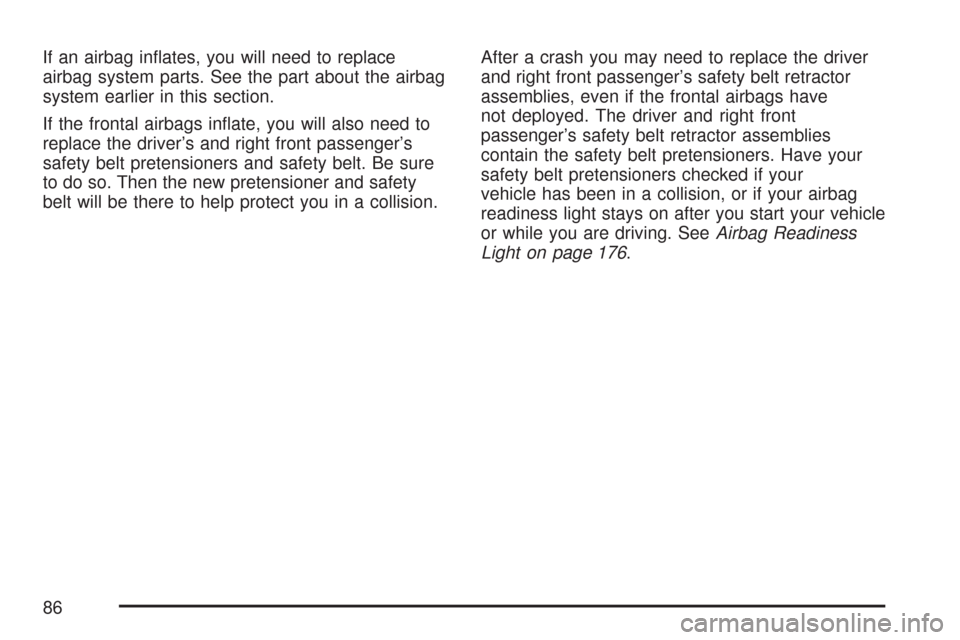
If an airbag inflates, you will need to replace
airbag system parts. See the part about the airbag
system earlier in this section.
If the frontal airbags inflate, you will also need to
replace the driver’s and right front passenger’s
safety belt pretensioners and safety belt. Be sure
to do so. Then the new pretensioner and safety
belt will be there to help protect you in a collision.After a crash you may need to replace the driver
and right front passenger’s safety belt retractor
assemblies, even if the frontal airbags have
not deployed. The driver and right front
passenger’s safety belt retractor assemblies
contain the safety belt pretensioners. Have your
safety belt pretensioners checked if your
vehicle has been in a collision, or if your airbag
readiness light stays on after you start your vehicle
or while you are driving. SeeAirbag Readiness
Light on page 176.
86
Page 94 of 436

Doors and Locks
Door Locks
{CAUTION:
Unlocked doors can be dangerous.
Passengers, especially children, can
easily open the doors and fall out of a
moving vehicle. When a door is
locked, the handle will not open it.
You increase the chance of being
thrown out of the vehicle in a crash if
the doors are not locked. So, wear
safety belts properly and lock the
doors whenever you drive.
Young children who get into unlocked
vehicles may be unable to get out. A
child can be overcome by extreme
CAUTION: (Continued)
CAUTION: (Continued)
heat and can suffer permanent injuries
or even death from heat stroke.
Always lock your vehicle whenever
you leave it.
Outsiders can easily enter through an
unlocked door when you slow down
or stop your vehicle. Locking your
doors can help prevent this from
happening.
There are several ways to lock and unlock your
vehicle.
From the outside, use your key or the Remote
Keyless Entry (RKE) transmitter. SeeRemote
Keyless Entry (RKE) System Operation on
page 91.
To manually unlock the front doors from the
outside, insert the key and turn it toward the front
of the vehicle. To manually lock the doors from
the outside, insert the key and turn it toward
the rear of the vehicle.
94
Page 129 of 436
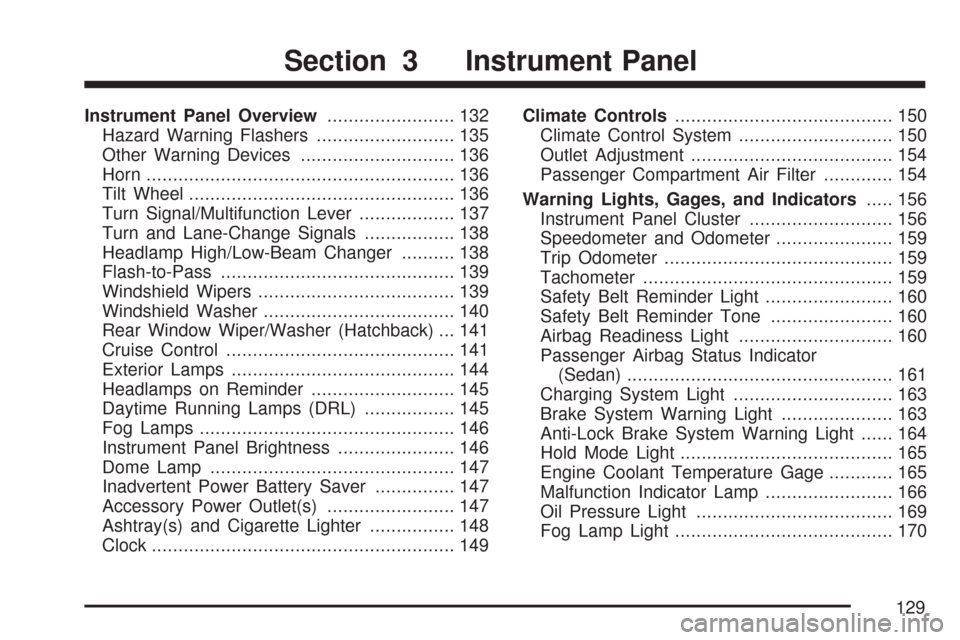
Instrument Panel Overview........................ 132
Hazard Warning Flashers.......................... 135
Other Warning Devices............................. 136
Horn.......................................................... 136
Tilt Wheel.................................................. 136
Turn Signal/Multifunction Lever.................. 137
Turn and Lane-Change Signals................. 138
Headlamp High/Low-Beam Changer.......... 138
Flash-to-Pass............................................ 139
Windshield Wipers..................................... 139
Windshield Washer.................................... 140
Rear Window Wiper/Washer (Hatchback) ... 141
Cruise Control........................................... 141
Exterior Lamps.......................................... 144
Headlamps on Reminder........................... 145
Daytime Running Lamps (DRL)................. 145
Fog Lamps................................................ 146
Instrument Panel Brightness...................... 146
Dome Lamp.............................................. 147
Inadvertent Power Battery Saver............... 147
Accessory Power Outlet(s)........................ 147
Ashtray(s) and Cigarette Lighter................ 148
Clock......................................................... 149Climate Controls......................................... 150
Climate Control System............................. 150
Outlet Adjustment...................................... 154
Passenger Compartment Air Filter............. 154
Warning Lights, Gages, and Indicators..... 156
Instrument Panel Cluster........................... 156
Speedometer and Odometer...................... 159
Trip Odometer........................................... 159
Tachometer............................................... 159
Safety Belt Reminder Light........................ 160
Safety Belt Reminder Tone....................... 160
Airbag Readiness Light............................. 160
Passenger Airbag Status Indicator
(Sedan).................................................. 161
Charging System Light.............................. 163
Brake System Warning Light..................... 163
Anti-Lock Brake System Warning Light...... 164
Hold Mode Light........................................ 165
Engine Coolant Temperature Gage............ 165
Malfunction Indicator Lamp........................ 166
Oil Pressure Light..................................... 169
Fog Lamp Light......................................... 170
Section 3 Instrument Panel
129
Page 130 of 436
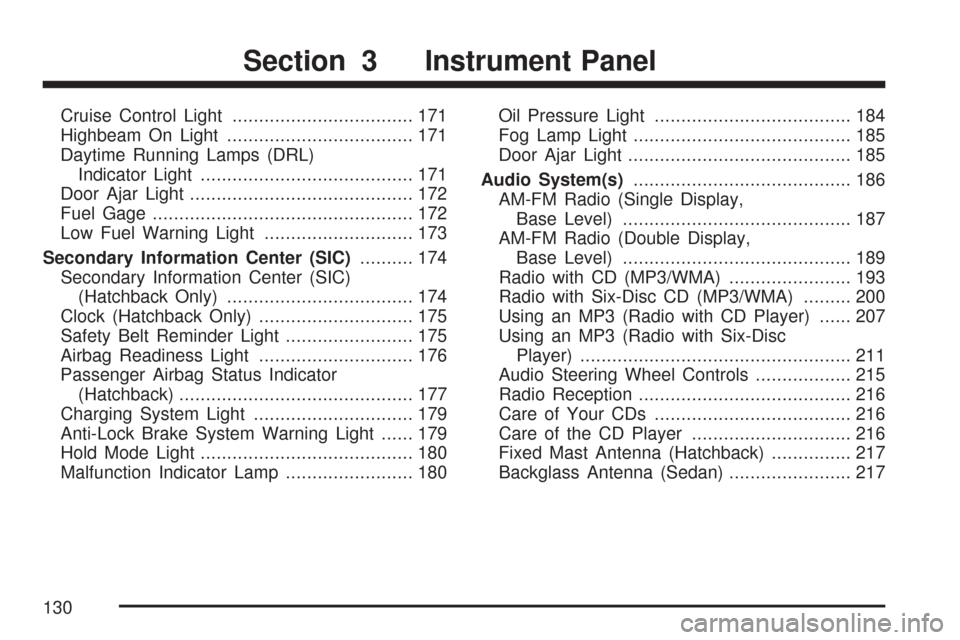
Cruise Control Light.................................. 171
Highbeam On Light................................... 171
Daytime Running Lamps (DRL)
Indicator Light........................................ 171
Door Ajar Light.......................................... 172
Fuel Gage................................................. 172
Low Fuel Warning Light............................ 173
Secondary Information Center (SIC).......... 174
Secondary Information Center (SIC)
(Hatchback Only)................................... 174
Clock (Hatchback Only)............................. 175
Safety Belt Reminder Light........................ 175
Airbag Readiness Light............................. 176
Passenger Airbag Status Indicator
(Hatchback)............................................ 177
Charging System Light.............................. 179
Anti-Lock Brake System Warning Light...... 179
Hold Mode Light........................................ 180
Malfunction Indicator Lamp........................ 180Oil Pressure Light..................................... 184
Fog Lamp Light......................................... 185
Door Ajar Light.......................................... 185
Audio System(s)......................................... 186
AM-FM Radio (Single Display,
Base Level)........................................... 187
AM-FM Radio (Double Display,
Base Level)........................................... 189
Radio with CD (MP3/WMA)....................... 193
Radio with Six-Disc CD (MP3/WMA)......... 200
Using an MP3 (Radio with CD Player)...... 207
Using an MP3 (Radio with Six-Disc
Player)................................................... 211
Audio Steering Wheel Controls.................. 215
Radio Reception........................................ 216
Care of Your CDs..................................... 216
Care of the CD Player.............................. 216
Fixed Mast Antenna (Hatchback)............... 217
Backglass Antenna (Sedan)....................... 217
Section 3 Instrument Panel
130
Page 160 of 436

Safety Belt Reminder Light
The safety belt light will
come on and stay on
until the driver’s
safety belt is buckled.
If the driver’s belt is already buckled, the light will
not come on.
Safety Belt Reminder Tone
If your vehicle has this feature, a tone will sound
for several seconds when the ignition is turned
to ON to remind people to fasten their safety belts.
The tone will not sound if the driver’s safety belt
is already buckled.
Airbag Readiness Light
There is an airbag readiness light on the
instrument panel cluster, which shows the airbag
symbol. The system checks the airbag’s
electrical system for malfunctions. The light tells
you if there is an electrical problem. The
system check includes the airbag sensor, the
airbag modules, the wiring and the crash sensing
and diagnostic module. For more information
on the airbag system, seeAirbag System
on page 68.
This light will come on
when you start your
vehicle, and it will flash
for a few seconds.
Then the light should go
out. This means the
system is ready.
160
Page 175 of 436
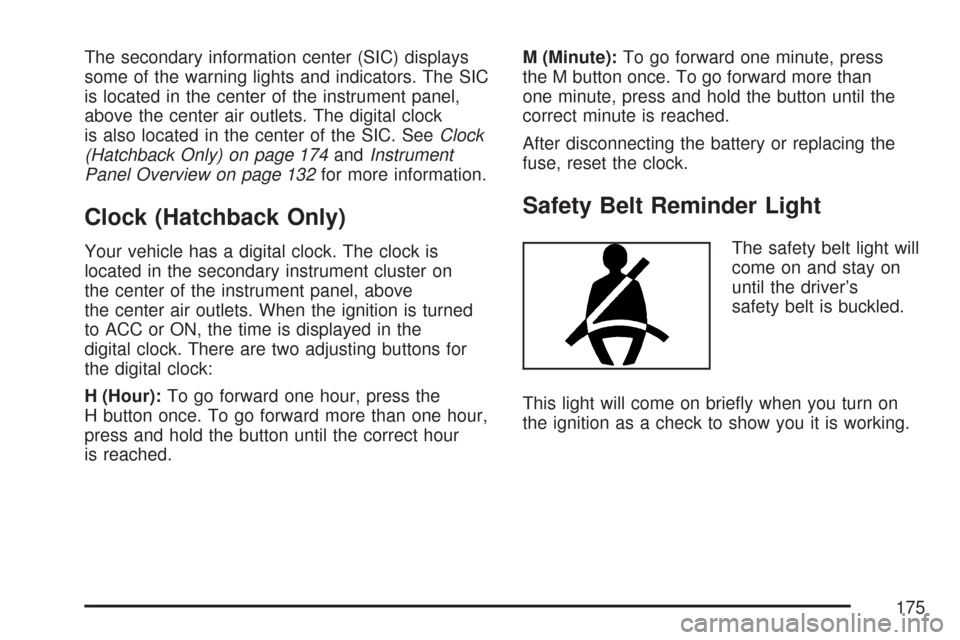
The secondary information center (SIC) displays
some of the warning lights and indicators. The SIC
is located in the center of the instrument panel,
above the center air outlets. The digital clock
is also located in the center of the SIC. SeeClock
(Hatchback Only) on page 174andInstrument
Panel Overview on page 132for more information.
Clock (Hatchback Only)
Your vehicle has a digital clock. The clock is
located in the secondary instrument cluster on
the center of the instrument panel, above
the center air outlets. When the ignition is turned
to ACC or ON, the time is displayed in the
digital clock. There are two adjusting buttons for
the digital clock:
H (Hour):To go forward one hour, press the
H button once. To go forward more than one hour,
press and hold the button until the correct hour
is reached.M (Minute):To go forward one minute, press
the M button once. To go forward more than
one minute, press and hold the button until the
correct minute is reached.
After disconnecting the battery or replacing the
fuse, reset the clock.
Safety Belt Reminder Light
The safety belt light will
come on and stay on
until the driver’s
safety belt is buckled.
This light will come on briefly when you turn on
the ignition as a check to show you it is working.
175
Page 220 of 436
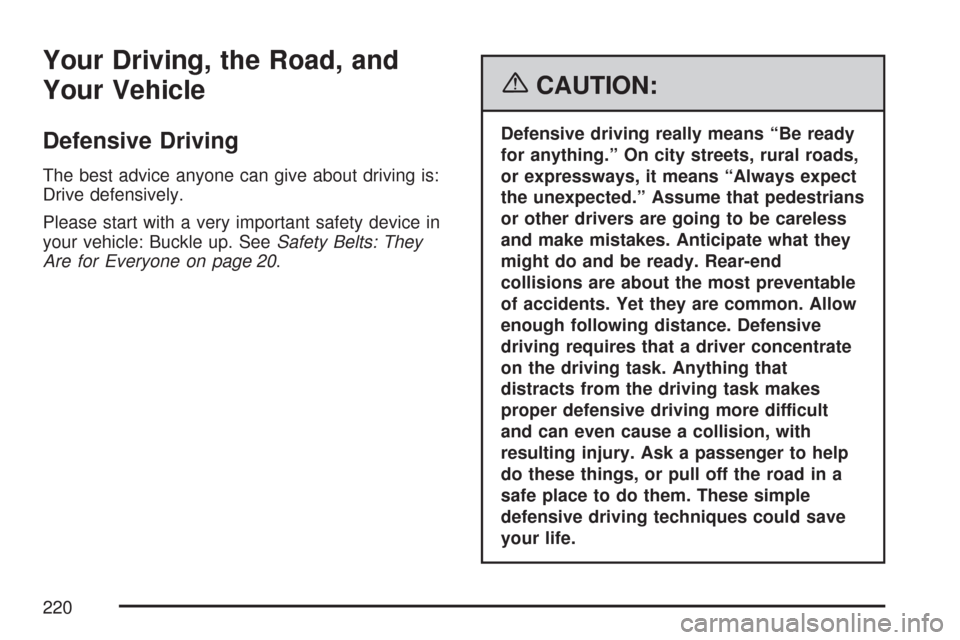
Your Driving, the Road, and
Your Vehicle
Defensive Driving
The best advice anyone can give about driving is:
Drive defensively.
Please start with a very important safety device in
your vehicle: Buckle up. SeeSafety Belts: They
Are for Everyone on page 20.
{CAUTION:
Defensive driving really means “Be ready
for anything.” On city streets, rural roads,
or expressways, it means “Always expect
the unexpected.” Assume that pedestrians
or other drivers are going to be careless
and make mistakes. Anticipate what they
might do and be ready. Rear-end
collisions are about the most preventable
of accidents. Yet they are common. Allow
enough following distance. Defensive
driving requires that a driver concentrate
on the driving task. Anything that
distracts from the driving task makes
proper defensive driving more difficult
and can even cause a collision, with
resulting injury. Ask a passenger to help
do these things, or pull off the road in a
safe place to do them. These simple
defensive driving techniques could save
your life.
220
Page 229 of 436
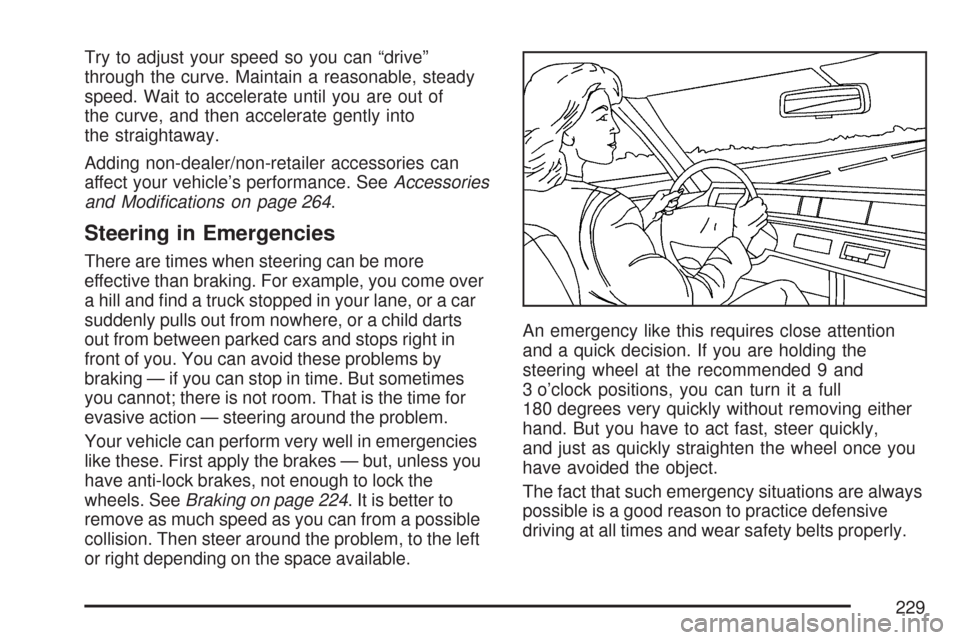
Try to adjust your speed so you can “drive”
through the curve. Maintain a reasonable, steady
speed. Wait to accelerate until you are out of
the curve, and then accelerate gently into
the straightaway.
Adding non-dealer/non-retailer accessories can
affect your vehicle’s performance. SeeAccessories
and Modifications on page 264.
Steering in Emergencies
There are times when steering can be more
effective than braking. For example, you come over
a hill and find a truck stopped in your lane, or a car
suddenly pulls out from nowhere, or a child darts
out from between parked cars and stops right in
front of you. You can avoid these problems by
braking — if you can stop in time. But sometimes
you cannot; there is not room. That is the time for
evasive action — steering around the problem.
Your vehicle can perform very well in emergencies
like these. First apply the brakes — but, unless you
have anti-lock brakes, not enough to lock the
wheels. SeeBraking on page 224. It is better to
remove as much speed as you can from a possible
collision. Then steer around the problem, to the left
or right depending on the space available.An emergency like this requires close attention
and a quick decision. If you are holding the
steering wheel at the recommended 9 and
3 o’clock positions, you can turn it a full
180 degrees very quickly without removing either
hand. But you have to act fast, steer quickly,
and just as quickly straighten the wheel once you
have avoided the object.
The fact that such emergency situations are always
possible is a good reason to practice defensive
driving at all times and wear safety belts properly.
229